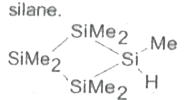On heating in excess supply of air, K, Rb and Cs form superoxides rather than oxides and peroxides?
K+,Rb+ and Cs+ are larger cations which stabilizeO−2 (superoxide) the larger anion. Thus when MO2 is formed, it is stabilized hence formation is preferred to oxides and peroxides.
Topper's Solved these Questions
- PREPARATION AND PROPERTIES OF COMPOUNDS AND GENERAL DISCUSSION OF S-AND P-BLOCK ELEMENTSBOOK - FIITJEECHAPTER - PREPARATION AND PROPERTIES OF COMPOUNDS AND GENERAL DISCUSSION OF S-AND P-BLOCK ELEMENTSEXERCISE - SOLVED PROBLEMS (SUBJECTIVE)Level-I
29 Videos
- PREPARATION AND PROPERTIES OF COMPOUNDS AND GENERAL DISCUSSION OF S-AND P-BLOCK ELEMENTSBOOK - FIITJEECHAPTER - PREPARATION AND PROPERTIES OF COMPOUNDS AND GENERAL DISCUSSION OF S-AND P-BLOCK ELEMENTSEXERCISE - SOLVED PROBLEMS (OBJECTIVE)
27 Videos
- PERIODIC PROTERTIES OF ELEMENTSBOOK - FIITJEECHAPTER - PERIODIC PROTERTIES OF ELEMENTSEXERCISE - COMPREHENSION
13 Videos
- QUALITATIVE ANALYSIS BOOK - FIITJEECHAPTER - QUALITATIVE ANALYSIS EXERCISE - Single interger answer type
3 Videos
Similar Questions
Comment on each of the following observations:
(a) When an aqueous solution of potassium cyanide is added to aluminium sulphate Al(OH)2 is precipitated.
(b) The carbide MgaCs liberated propyne (CH3C=CH) on treatment with water.
(c) Magnesium silicate reacts with ammonium bromide in liquid ammonia to form silane,
(d)is hydrolysed by aqueous alkali at the same rate as the corresponding Si-D compound.
View SolutionWhich of the following statements is incorrect?
View SolutionBohr's periodic table has seven horizontal rows called periods and eighteen vertical columns called groups. Alternatively, the elements of the Bohr's table are divided into four blocks namely S- and f-blocks. Group, period and block of given element can be predicted with the help of its electronic configuration.
(I) The principle quantum number of valence shell refers to period of elements
(II) The nature of subshell (S. p or d) having last electron refers the block to which the element belongs.
(III) The number of electrons present in outermost or penultimate shell predicts the group of element.
For s-block, the group number = No. of valence electron
For p-block, the group number =10+ numbers of valence electron
For d-block, the group number =2+(n−1)d electrons
The element of atomic number 36 belongs to
View SolutionNumber of oxygen atoms in molybdate ion is
View SolutionWhy is that on being heated in excess supply of air , K , Rb and Cs form superoxides in preference to oxide and peroxides ?
View SolutionOut of Li , Na , K , Rb and Cs , how many of them directly form superoxides on heating with dioxygen ?
View SolutionAssertion . K , Rb and Cs form superoxides . Reason . The stability of the superoxides increases from K to Cs due to decrease in lattice energy .
View SolutionAssertion: K, Rb and Cs form superoxides. Reason: The stability of the superoxides increases from 'K' to 'Cs' due to decrease in lattice energy.
View SolutionK, Rb तथा Cs मुख्यतः सुपरऑक्साइड बनाते हैं ।
View SolutionAssertion : K,Rb and Cs form superoxides.
Reason : The stability of the superoxide increases from 'K' to Cs due to decrease in lattice energy
View SolutionAssertain (A): K, Rb and Cs form superoxides.
Reason (R) : The stability of the superoxides increases from 'K' to 'Cs' due to decrease in lattice energy.
The correct answer is
View SolutionOne reason on heating in excess supply of air K, Rb and Cs from superoxide on preference to oxide and peroxides?
View Solutionনীচের কোন জোড়টির মৌলগুলিকে অতিরিক্ত বায়ুতে উত্তপ্ত করলে যথাক্রমে সুপার অক্সাইড ও পারঅক্সাইড গঠিত হয় -
View SolutionWhy is that on being heated in excess supply of air, K, Rb and Cs form superoxides in preference to oxide and peroxides?
View SolutionAssertion : K, Rb and Cs can also form superoxides.
Reason : Their ionic radii increase in the order Cs+<Rb+<K+.
View Solution

